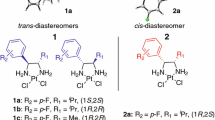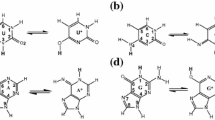Abstract
The interaction of the two chiral isomers of the new anticancer agent [Pt(ampyr)(cbdca)] (ampyr=aminomethylpyrrolidine, cbdca=cyclobutanedicarboxylate) with 5′-GMP and with short G-containing oligonucleotides has been studied using 1H and 31P NMR, UV-vis spectroscopy and molecular modelling. Each isomer loses the cbdca ligand upon binding to the DNA fragments. Two geometrical isomers of the DNA adducts are formed owing to the presence of the unsymmetric ampyr ligand. These isomers prove to be GG-N7,N7 chelates for d(GpG), d(pGpG) and d(CpGpG). A slight preference for the formation of one geometrical isomer is found in the case of DNA fragments having a phosphate moiety and/or a C base at the 5′-site of the GG sequence. H-bonding interactions from the NH2 moiety towards the 5′-phosphate group and/or the O atom of the C base clearly favour the formation of one geometrical isomer. The presence of these H-bonds, together with the bulky pyrrolidine ring, has resulted in the unique observation (by 1H NMR) of NH protons of coordinated amines that do not rapidly exchange in a 99.95% D2O solution. Temperature-dependence studies show an extremely slow stack ⇄ destack conformational change for the CGG adducts of the S isomer, which could be related to these stable H-bonds of the amine protons towards the oligonucleotide. For the R isomer this stack ⇄ destack conformational change is faster, probably owing to more steric hindrance of the pyrrolidine ring as deduced from the NOESY data, and as also suggested by molecular modelling. The observation of extremely slow rotation around the Pt-N7 bond for [Pt(R-ampyr)(GMP-N7)2] provides further evidence for increased steric hindrance of the R isomer compared to the S isomer. The rate of binding of the drug to G bases proved to be second order for both isomers; in fact the (toxic) S isomer is about two times more reactive than the (non-toxic) R isomer, as seen from k 2 values of 0.17±0.01 M–1 s–1 for [Pt(S-ampyr)(cbdca)] and 0.09±0.01 M–1 s–1 for [Pt(R-ampyr)(cbdca)]. No solvent-assisted pathway is involved in these reactions, since the complexes prove to be stable in solution for weeks and therefore only a direct attack of the G base on the Pt must be involved. Because hardly any intermediate species can be detected during the reaction, coordination of the second G base must occur much faster than the binding of the first G base. Since direct attack of the nucleobases takes place, steric interactions become extremely important and therefore are likely to determine the reactivity, activity and even the toxicity of such Pt complexes.
Similar content being viewed by others
Author information
Authors and Affiliations
Additional information
Received: 12 January 1999 / Accepted: 17 June 1999
Rights and permissions
About this article
Cite this article
Bloemink, M., Pérez, J., Heetebrij, R. et al. The new anticancer drug [(2R )-aminomethylpyrrolidine](1,1-cyclobutanedicarboxylato)platinum(II) and its toxic S enantiomer do interact differently with nucleic acids. JBIC 4, 554–567 (1999). https://doi.org/10.1007/s007750050378
Issue Date:
DOI: https://doi.org/10.1007/s007750050378




